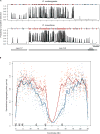Molecular Evolution at a Meiosis Gene Mediates Species Differences in the Rate and Patterning of Recombination
- PMID: 29606420
- PMCID: PMC5915966
- DOI: 10.1016/j.cub.2018.02.056
Molecular Evolution at a Meiosis Gene Mediates Species Differences in the Rate and Patterning of Recombination
Abstract
Crossing over between homologous chromosomes during meiosis repairs programmed DNA double-strand breaks, ensures proper segregation at meiosis I [1], shapes the genomic distribution of nucleotide variability in populations, and enhances the efficacy of natural selection among genetically linked sites [2]. Between closely related Drosophila species, large differences exist in the rate and chromosomal distribution of crossing over. Little, however, is known about the molecular genetic changes or population genetic forces that mediate evolved differences in recombination between species [3, 4]. Here, we show that a meiosis gene with a history of rapid evolution acts as a trans-acting modifier of species differences in crossing over. In transgenic flies, the dicistronic gene, mei-217/mei-218, recapitulates a large part of the species differences in the rate and chromosomal distribution of crossing over. These phenotypic differences appear to result from changes in protein sequence not gene expression. Our population genetics analyses show that the protein-coding sequence of mei-218, but not mei-217, has a history of recurrent positive natural selection. By modulating the intensity of centromeric and telomeric suppression of crossing over, evolution at mei-217/-218 has incidentally shaped gross differences in the chromosomal distribution of nucleotide variability between species. We speculate that recurrent bouts of adaptive evolution at mei-217/-218 might reflect a history of coevolution with selfish genetic elements.
Keywords: Drosophila; centromere effect; crossing over; evolution; genetic hitchhiking; interference; positive selection; recombination.
Copyright © 2018 Elsevier Ltd. All rights reserved.
Conflict of interest statement
The authors declare no competing interests.
Figures


Comment in
-
Evolution: Increased Recombination Caused by a Single Gene.Curr Biol. 2018 Apr 23;28(8):R342-R344. doi: 10.1016/j.cub.2018.02.072. Curr Biol. 2018. PMID: 29689205
Similar articles
-
Positive Selection and Functional Divergence at Meiosis Genes That Mediate Crossing Over Across the Drosophila Phylogeny.G3 (Bethesda). 2019 Oct 7;9(10):3201-3211. doi: 10.1534/g3.119.400280. G3 (Bethesda). 2019. PMID: 31362974 Free PMC article.
-
Loss of Drosophila Mei-41/ATR Alters Meiotic Crossover Patterning.Genetics. 2018 Feb;208(2):579-588. doi: 10.1534/genetics.117.300634. Epub 2017 Dec 15. Genetics. 2018. PMID: 29247012 Free PMC article.
-
Studies on crossover-specific mutants and the distribution of crossing over in Drosophila females.Cytogenet Genome Res. 2004;107(3-4):160-71. doi: 10.1159/000080594. Cytogenet Genome Res. 2004. PMID: 15467361
-
Female Meiosis: Synapsis, Recombination, and Segregation in Drosophila melanogaster.Genetics. 2018 Mar;208(3):875-908. doi: 10.1534/genetics.117.300081. Genetics. 2018. PMID: 29487146 Free PMC article. Review.
-
Repression of harmful meiotic recombination in centromeric regions.Semin Cell Dev Biol. 2016 Jun;54:188-97. doi: 10.1016/j.semcdb.2016.01.042. Epub 2016 Feb 3. Semin Cell Dev Biol. 2016. PMID: 26849908 Free PMC article. Review.
Cited by
-
Positive Selection and Functional Divergence at Meiosis Genes That Mediate Crossing Over Across the Drosophila Phylogeny.G3 (Bethesda). 2019 Oct 7;9(10):3201-3211. doi: 10.1534/g3.119.400280. G3 (Bethesda). 2019. PMID: 31362974 Free PMC article.
-
Meiotic, genomic and evolutionary properties of crossover distribution in Drosophila yakuba.PLoS Genet. 2022 Mar 23;18(3):e1010087. doi: 10.1371/journal.pgen.1010087. eCollection 2022 Mar. PLoS Genet. 2022. PMID: 35320272 Free PMC article.
-
The evolution of recombination in self-fertilizing organisms.Genetics. 2022 Aug 30;222(1):iyac114. doi: 10.1093/genetics/iyac114. Genetics. 2022. PMID: 35929790 Free PMC article.
-
Selection Can Favor a Recombination Landscape That Limits Polygenic Adaptation.Mol Biol Evol. 2025 Jan 6;42(1):msae273. doi: 10.1093/molbev/msae273. Mol Biol Evol. 2025. PMID: 39776196 Free PMC article.
-
Meiotic Crossover Patterning.Front Cell Dev Biol. 2021 Jul 22;9:681123. doi: 10.3389/fcell.2021.681123. eCollection 2021. Front Cell Dev Biol. 2021. PMID: 34368131 Free PMC article. Review.
References
-
- Egel R, Lankenau D-H. Recombination and Meiosis: Crossing-over and Disjunction. Berlin: Springer; 2008.
-
- Ritz KR, Noor MAF, Singh ND. Variation in recombination rate: adaptive or not? Trends in Genetics. 2017;33:364–374. - PubMed
-
- Fisher RA. The Genetical Theory of Natural Selection. Oxford: Oxford University Press; 1930.
Publication types
MeSH terms
Substances
Grants and funding
LinkOut - more resources
Full Text Sources
Other Literature Sources
Molecular Biology Databases

